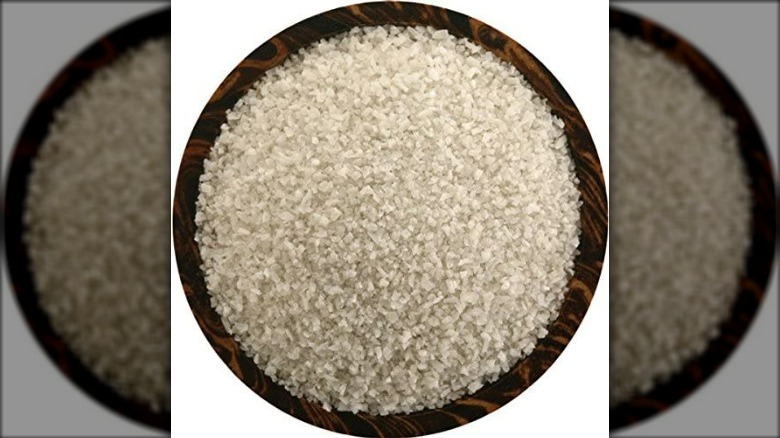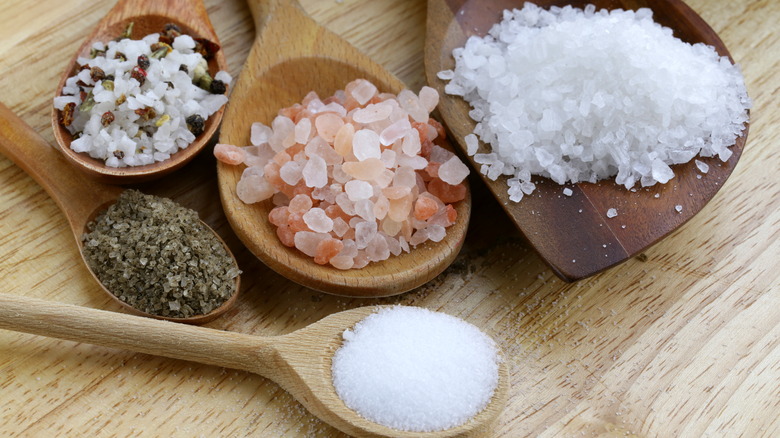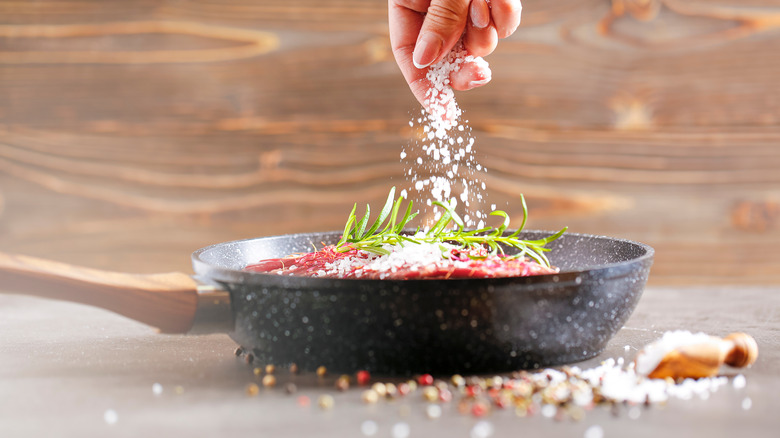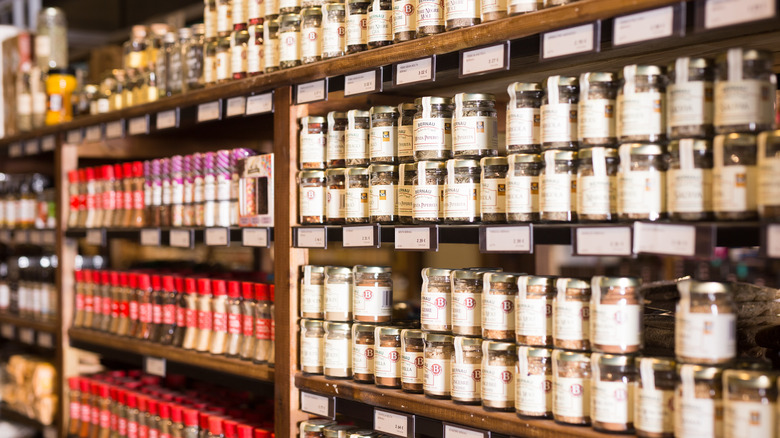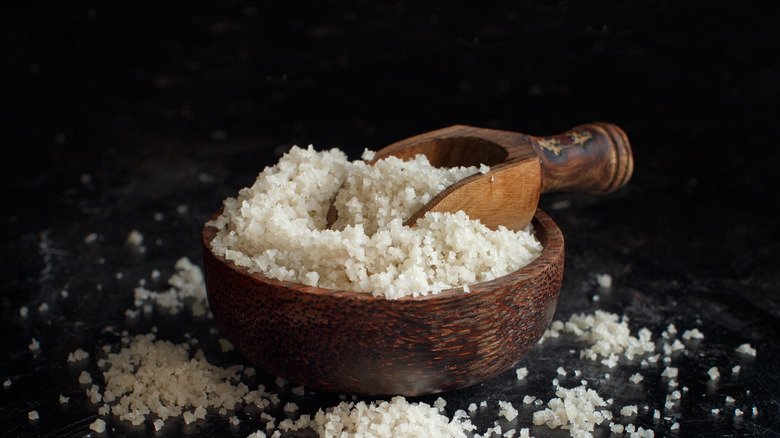What Sets Sel Gris Apart From Regular Sea Salt?
Salt is one of the most important, baseline ingredients when it comes to cooking anything, from savory to sweet. It is a rare occurrence that you would find a household without at least one kind of salt, if not a few options. While you may only be familiar with sea salt or basic table salt, there are a wide range of different salts to achieve different flavors and textures in your cooking.
For thicker flakes that dissolve quickly, you may want to use kosher salt, for example. Sea salt is heralded over table salt for its smoother flavor, black salt is unique for its sulfur content and flavor, and Himalayan salt is sought out for its rich color (via Blue Apron). This just scratches the surface of the wide range of salts you could add to your spice collection. One of the shining stars in the salt world, though, is sel gris, a gray-tinted salt harvested from French salt marshes.
What is sel gris?
Sel gris is a French term, which literally translates to gray salt, and is also commonly called Celtic sea salt, per Food Republic. As the name would suggest, sel gris has a slight gray hue to the salt crystals. This is due to the harvesting process, in which clay basins are set underwater in the Atlantic Ocean. Once the water evaporates, it leaves behind natural salt deposits, which are much richer in minerals than traditional sea salt, creating sel gris' signature gray tint (via Recipe Tips).
Like regular sea salt, sel gris can be found ground into fine salt flakes, as well as in larger salt crystal form. The salt is French in more than just name — the highest quality batches are harvested from French coasts, including Normandy, Ile de Re, and the Guérande region. Sel gris is very similar in taste and texture to regular sea salt, but just a touch more rich and sophisticated, as Salt Traders describes it.
How is sel gris made?
Sel gris is collected using traditional salt harvesting methods, in which clay lined basins are set up to collect sea water off the Atlantic coast in France. The basins are incredibly shallow, and as the sun beats down on them, the water evaporates and leaves behind salt deposits, explains Exploring Our Fluid Earth. Then, the crystals are left to fall to the bottom of the basin and someone then comes through and rakes them up.
Sel gris is an unrefined salt, notes Recipe Tips, so all of the minerals that are deposited alongside the natural sea salt don't just color the crystals, but also flavor them. The flavor will be a bit more oceanic, with higher amounts of iron, calcium, zinc, magnesium, and more. All the harvesting process requires is evaporation and some raking. From there, it's up to distributors to decide if they'll sell the product in coarse crystals or fine flakes. This process is similar to the fleur de sel harvesting process, but a lot simpler.
Sel gris vs. other salts
There are a plethora of different types of cooking salts, all with slightly different flavor profiles and purposes. Sel gris may not be nearly as well known or highly lauded as sea salt or kosher salt, but it certainly deserves to be. According to SaltWorks, sel gris is versatile enough to replace the most commonly used salts. Finer grains can be used to season food or finish off a meal, and thicker crystals can be used to top off baked goods.
In terms of comparing sel gris to other salts, it stands toe to toe with kosher and sea salt's versatility and range, with just a slightly more gourmet flavor palette. As mentioned earlier, it has a natural, rich flavor inspired by the sea, making it just a slight upgrade. It differs from kosher salt in that it doesn't extract moisture from meats or vegetables. Despite its unique appearance, the flavor profile isn't as dramatically different from traditional sea salt as the sulfur-rich black salt (via Food Republic).
How to cook with it
Sel gris is just as versatile as most cooking salts, and can be used for both seasoning food as well as finishing or topping it off. However, it does have a distinct taste and texture that makes it more ideal for certain foods. Due to the collection process, the salt has a bit of a stronger, briny taste, notes Dragon Herbs.
For this reason, the French salt is great for dishes with heavier flavor profiles, including roasted vegetables, seafood, soups, and hearty stews, to name a few. However, the flavor isn't so strong that it can't be used in lighter foods, like topping off a salad, or even in baking. In fact, sel gris is a great replacement for regular sea salt, so feel free to sprinkle some on your next batch of chocolate chip cookies. According to Hepp's Salt Co., sel gris also has a lower amount of sodium than regular sea salt, making it a great way to flavor your food if you're watching your sodium intake.
Where to buy sel gris
While sel gris and fleur de sel have similar harvesting set ups, sel gris is much less labor intensive to actually collect, making it much more affordable. However, it isn't as popular or exclusive, making it harder to find at normal grocery stores. The best place to buy sel gris is online from either a spice or salt retailer. You can even find it on Amazon for $15 for a 2-pound bag, or $0.47 per ounce.
If you want to look for it in person, consider checking out local spice shops, which tend to stock more hard-to-find spices, spice blends, and salts. Since it is such a popular French salt, you could also try your luck with a specialty French cuisine store. Regardless if you buy it in person or online, make sure you look for sel gris that hails from French coasts, advises Food Republic. Some sel gris is harvested from Mediterranean coasts, but the most authentic salt in both origin and taste will come from Brittany, and more specifically Guérande.
Nutrition
Sel gris is heralded for more than just its unique color and rich flavor — it is also rich in minerals from the Atlantic Ocean, making it a more nutritional salt option. It has more than regular sea salt's baseline elements, as well as added minerals on top of that, notes The Paleo Diet.
It is estimated that 100 grams of sel gris contains 34 grams of sodium and 109 milligrams of potassium, compared to sea salt's higher sodium content of 39 grams, and just 8 milligrams of potassium — sel gris gives you better mineral content without being excessively high in sodium (via Fatsecret). It also has additional minerals only found in trace amounts in regular sea salt, including 34 milligrams of magnesium, 287 milligrams of calcium, 11 milligrams of iron, 1 milligram of manganese, and 0.35 milligrams of zinc. Sel gris may not supplement your daily requirement of minerals, but it can certainly help boost the nutritional value of your daily meals.

